Medicine and Health Report: Affordability and Treatment Analysis
VerifiedAdded on 2023/06/03
|5
|1174
|437
Report
AI Summary
This report analyzes two articles related to medicine and health. The first article investigates the availability and affordability of essential diabetes medications across different income levels, revealing disparities in access to crucial drugs like insulin. It highlights the challenges faced by low and middle-income countries in providing affordable diabetes treatment. The second article explores the use of catheter ablation for patients with heart failure and atrial fibrillation, presenting findings that demonstrate the potential of this treatment to reduce mortality and improve patient outcomes compared to medical therapy. The report discusses the strengths and weaknesses of each study, emphasizing the contributions of the research to understanding and addressing critical public health issues related to diabetes and heart disease.
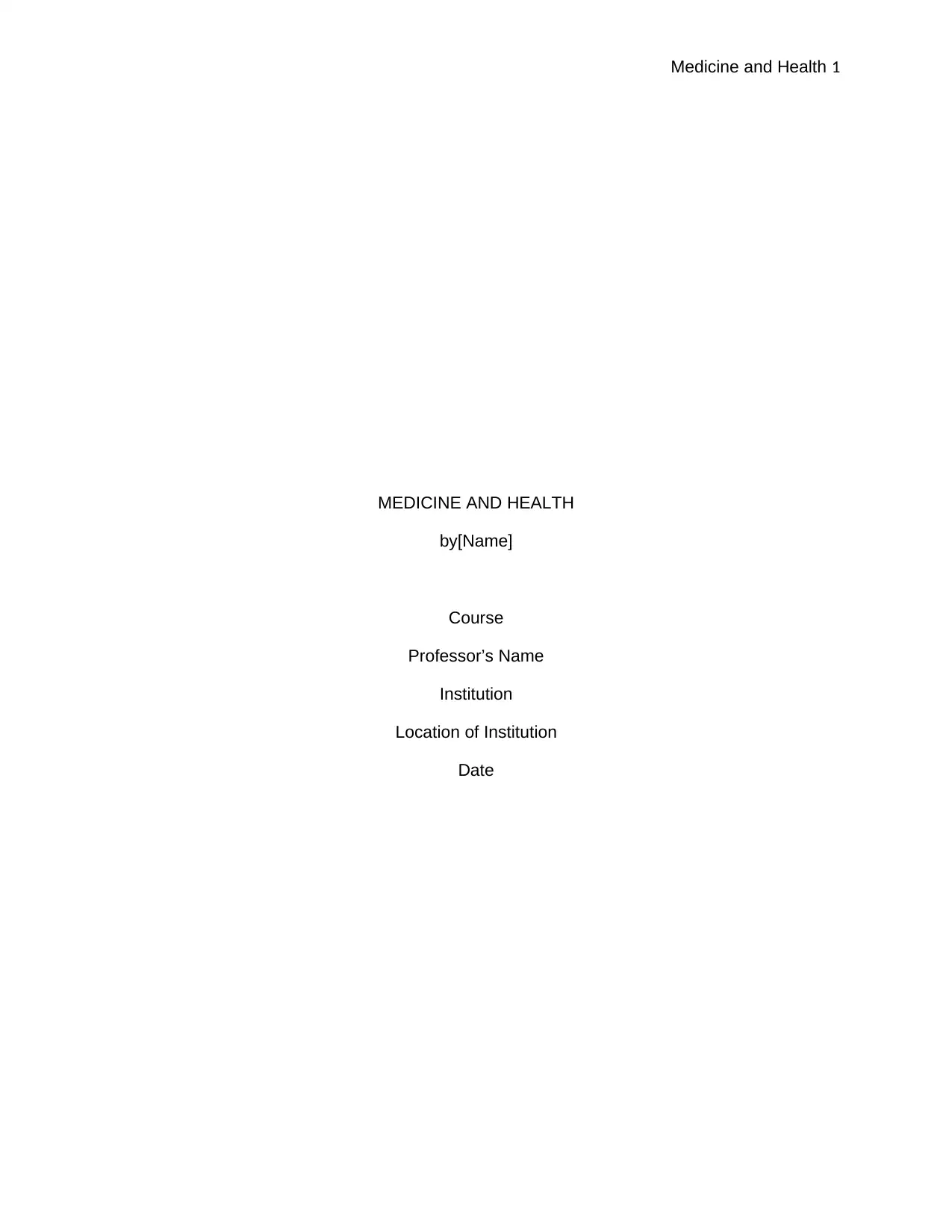
Medicine and Health 1
MEDICINE AND HEALTH
by[Name]
Course
Professor’s Name
Institution
Location of Institution
Date
MEDICINE AND HEALTH
by[Name]
Course
Professor’s Name
Institution
Location of Institution
Date
Paraphrase This Document
Need a fresh take? Get an instant paraphrase of this document with our AI Paraphraser
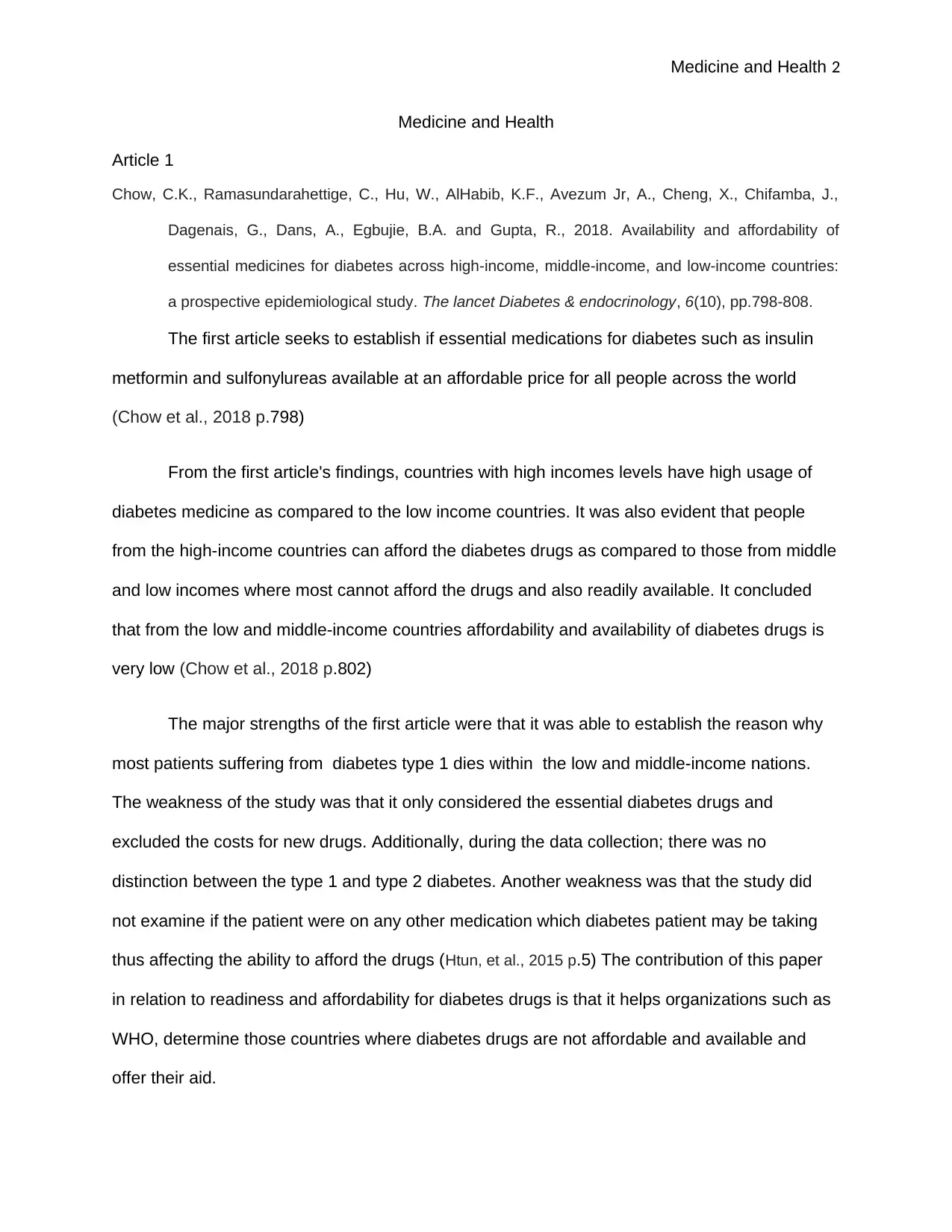
Medicine and Health 2
Medicine and Health
Article 1
Chow, C.K., Ramasundarahettige, C., Hu, W., AlHabib, K.F., Avezum Jr, A., Cheng, X., Chifamba, J.,
Dagenais, G., Dans, A., Egbujie, B.A. and Gupta, R., 2018. Availability and affordability of
essential medicines for diabetes across high-income, middle-income, and low-income countries:
a prospective epidemiological study. The lancet Diabetes & endocrinology, 6(10), pp.798-808.
The first article seeks to establish if essential medications for diabetes such as insulin
metformin and sulfonylureas available at an affordable price for all people across the world
(Chow et al., 2018 p.798)
From the first article's findings, countries with high incomes levels have high usage of
diabetes medicine as compared to the low income countries. It was also evident that people
from the high-income countries can afford the diabetes drugs as compared to those from middle
and low incomes where most cannot afford the drugs and also readily available. It concluded
that from the low and middle-income countries affordability and availability of diabetes drugs is
very low (Chow et al., 2018 p.802)
The major strengths of the first article were that it was able to establish the reason why
most patients suffering from diabetes type 1 dies within the low and middle-income nations.
The weakness of the study was that it only considered the essential diabetes drugs and
excluded the costs for new drugs. Additionally, during the data collection; there was no
distinction between the type 1 and type 2 diabetes. Another weakness was that the study did
not examine if the patient were on any other medication which diabetes patient may be taking
thus affecting the ability to afford the drugs (Htun, et al., 2015 p.5) The contribution of this paper
in relation to readiness and affordability for diabetes drugs is that it helps organizations such as
WHO, determine those countries where diabetes drugs are not affordable and available and
offer their aid.
Medicine and Health
Article 1
Chow, C.K., Ramasundarahettige, C., Hu, W., AlHabib, K.F., Avezum Jr, A., Cheng, X., Chifamba, J.,
Dagenais, G., Dans, A., Egbujie, B.A. and Gupta, R., 2018. Availability and affordability of
essential medicines for diabetes across high-income, middle-income, and low-income countries:
a prospective epidemiological study. The lancet Diabetes & endocrinology, 6(10), pp.798-808.
The first article seeks to establish if essential medications for diabetes such as insulin
metformin and sulfonylureas available at an affordable price for all people across the world
(Chow et al., 2018 p.798)
From the first article's findings, countries with high incomes levels have high usage of
diabetes medicine as compared to the low income countries. It was also evident that people
from the high-income countries can afford the diabetes drugs as compared to those from middle
and low incomes where most cannot afford the drugs and also readily available. It concluded
that from the low and middle-income countries affordability and availability of diabetes drugs is
very low (Chow et al., 2018 p.802)
The major strengths of the first article were that it was able to establish the reason why
most patients suffering from diabetes type 1 dies within the low and middle-income nations.
The weakness of the study was that it only considered the essential diabetes drugs and
excluded the costs for new drugs. Additionally, during the data collection; there was no
distinction between the type 1 and type 2 diabetes. Another weakness was that the study did
not examine if the patient were on any other medication which diabetes patient may be taking
thus affecting the ability to afford the drugs (Htun, et al., 2015 p.5) The contribution of this paper
in relation to readiness and affordability for diabetes drugs is that it helps organizations such as
WHO, determine those countries where diabetes drugs are not affordable and available and
offer their aid.
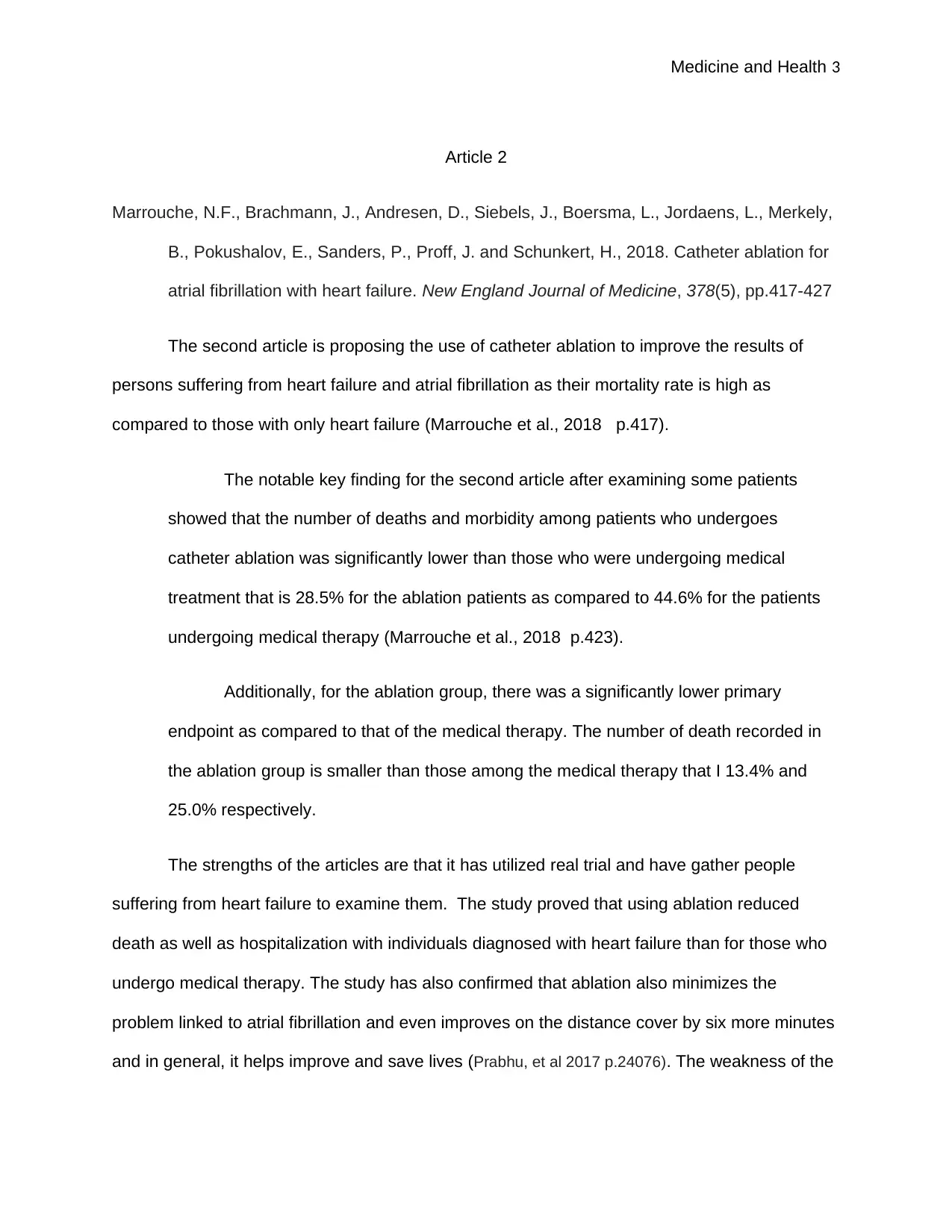
Medicine and Health 3
Article 2
Marrouche, N.F., Brachmann, J., Andresen, D., Siebels, J., Boersma, L., Jordaens, L., Merkely,
B., Pokushalov, E., Sanders, P., Proff, J. and Schunkert, H., 2018. Catheter ablation for
atrial fibrillation with heart failure. New England Journal of Medicine, 378(5), pp.417-427
The second article is proposing the use of catheter ablation to improve the results of
persons suffering from heart failure and atrial fibrillation as their mortality rate is high as
compared to those with only heart failure (Marrouche et al., 2018 p.417).
The notable key finding for the second article after examining some patients
showed that the number of deaths and morbidity among patients who undergoes
catheter ablation was significantly lower than those who were undergoing medical
treatment that is 28.5% for the ablation patients as compared to 44.6% for the patients
undergoing medical therapy (Marrouche et al., 2018 p.423).
Additionally, for the ablation group, there was a significantly lower primary
endpoint as compared to that of the medical therapy. The number of death recorded in
the ablation group is smaller than those among the medical therapy that I 13.4% and
25.0% respectively.
The strengths of the articles are that it has utilized real trial and have gather people
suffering from heart failure to examine them. The study proved that using ablation reduced
death as well as hospitalization with individuals diagnosed with heart failure than for those who
undergo medical therapy. The study has also confirmed that ablation also minimizes the
problem linked to atrial fibrillation and even improves on the distance cover by six more minutes
and in general, it helps improve and save lives (Prabhu, et al 2017 p.24076). The weakness of the
Article 2
Marrouche, N.F., Brachmann, J., Andresen, D., Siebels, J., Boersma, L., Jordaens, L., Merkely,
B., Pokushalov, E., Sanders, P., Proff, J. and Schunkert, H., 2018. Catheter ablation for
atrial fibrillation with heart failure. New England Journal of Medicine, 378(5), pp.417-427
The second article is proposing the use of catheter ablation to improve the results of
persons suffering from heart failure and atrial fibrillation as their mortality rate is high as
compared to those with only heart failure (Marrouche et al., 2018 p.417).
The notable key finding for the second article after examining some patients
showed that the number of deaths and morbidity among patients who undergoes
catheter ablation was significantly lower than those who were undergoing medical
treatment that is 28.5% for the ablation patients as compared to 44.6% for the patients
undergoing medical therapy (Marrouche et al., 2018 p.423).
Additionally, for the ablation group, there was a significantly lower primary
endpoint as compared to that of the medical therapy. The number of death recorded in
the ablation group is smaller than those among the medical therapy that I 13.4% and
25.0% respectively.
The strengths of the articles are that it has utilized real trial and have gather people
suffering from heart failure to examine them. The study proved that using ablation reduced
death as well as hospitalization with individuals diagnosed with heart failure than for those who
undergo medical therapy. The study has also confirmed that ablation also minimizes the
problem linked to atrial fibrillation and even improves on the distance cover by six more minutes
and in general, it helps improve and save lives (Prabhu, et al 2017 p.24076). The weakness of the
⊘ This is a preview!⊘
Do you want full access?
Subscribe today to unlock all pages.

Trusted by 1+ million students worldwide
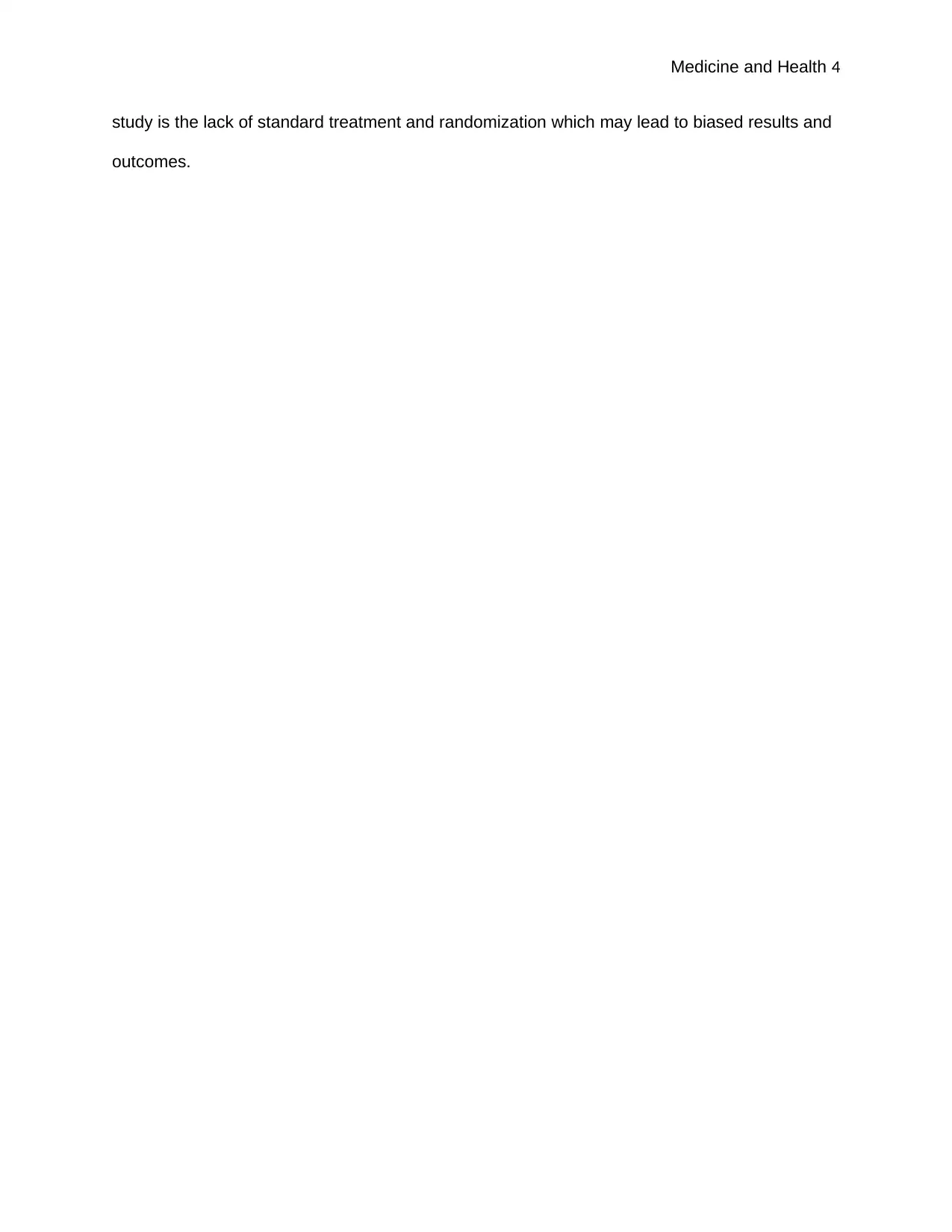
Medicine and Health 4
study is the lack of standard treatment and randomization which may lead to biased results and
outcomes.
study is the lack of standard treatment and randomization which may lead to biased results and
outcomes.
Paraphrase This Document
Need a fresh take? Get an instant paraphrase of this document with our AI Paraphraser
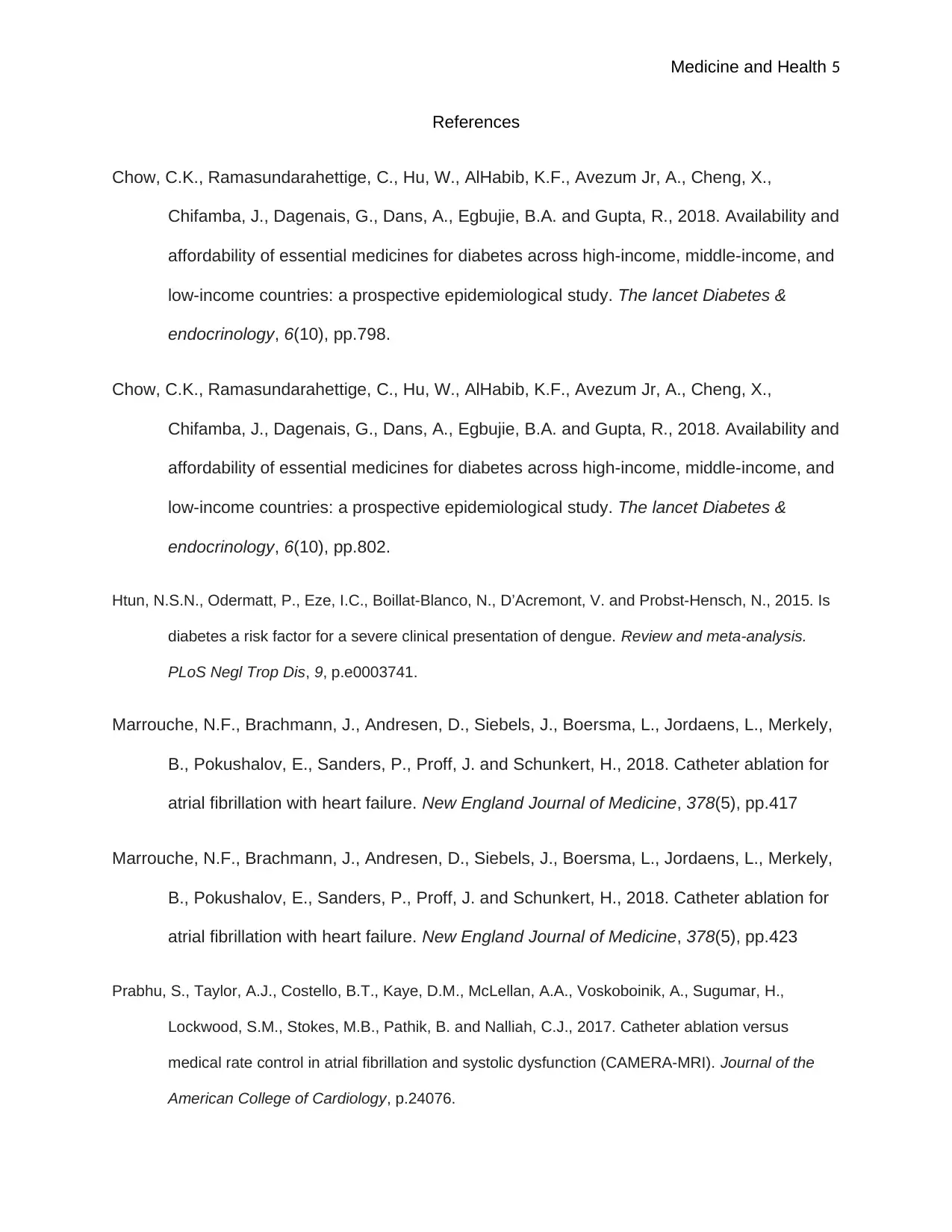
Medicine and Health 5
References
Chow, C.K., Ramasundarahettige, C., Hu, W., AlHabib, K.F., Avezum Jr, A., Cheng, X.,
Chifamba, J., Dagenais, G., Dans, A., Egbujie, B.A. and Gupta, R., 2018. Availability and
affordability of essential medicines for diabetes across high-income, middle-income, and
low-income countries: a prospective epidemiological study. The lancet Diabetes &
endocrinology, 6(10), pp.798.
Chow, C.K., Ramasundarahettige, C., Hu, W., AlHabib, K.F., Avezum Jr, A., Cheng, X.,
Chifamba, J., Dagenais, G., Dans, A., Egbujie, B.A. and Gupta, R., 2018. Availability and
affordability of essential medicines for diabetes across high-income, middle-income, and
low-income countries: a prospective epidemiological study. The lancet Diabetes &
endocrinology, 6(10), pp.802.
Htun, N.S.N., Odermatt, P., Eze, I.C., Boillat-Blanco, N., D’Acremont, V. and Probst-Hensch, N., 2015. Is
diabetes a risk factor for a severe clinical presentation of dengue. Review and meta-analysis.
PLoS Negl Trop Dis, 9, p.e0003741.
Marrouche, N.F., Brachmann, J., Andresen, D., Siebels, J., Boersma, L., Jordaens, L., Merkely,
B., Pokushalov, E., Sanders, P., Proff, J. and Schunkert, H., 2018. Catheter ablation for
atrial fibrillation with heart failure. New England Journal of Medicine, 378(5), pp.417
Marrouche, N.F., Brachmann, J., Andresen, D., Siebels, J., Boersma, L., Jordaens, L., Merkely,
B., Pokushalov, E., Sanders, P., Proff, J. and Schunkert, H., 2018. Catheter ablation for
atrial fibrillation with heart failure. New England Journal of Medicine, 378(5), pp.423
Prabhu, S., Taylor, A.J., Costello, B.T., Kaye, D.M., McLellan, A.A., Voskoboinik, A., Sugumar, H.,
Lockwood, S.M., Stokes, M.B., Pathik, B. and Nalliah, C.J., 2017. Catheter ablation versus
medical rate control in atrial fibrillation and systolic dysfunction (CAMERA-MRI). Journal of the
American College of Cardiology, p.24076.
References
Chow, C.K., Ramasundarahettige, C., Hu, W., AlHabib, K.F., Avezum Jr, A., Cheng, X.,
Chifamba, J., Dagenais, G., Dans, A., Egbujie, B.A. and Gupta, R., 2018. Availability and
affordability of essential medicines for diabetes across high-income, middle-income, and
low-income countries: a prospective epidemiological study. The lancet Diabetes &
endocrinology, 6(10), pp.798.
Chow, C.K., Ramasundarahettige, C., Hu, W., AlHabib, K.F., Avezum Jr, A., Cheng, X.,
Chifamba, J., Dagenais, G., Dans, A., Egbujie, B.A. and Gupta, R., 2018. Availability and
affordability of essential medicines for diabetes across high-income, middle-income, and
low-income countries: a prospective epidemiological study. The lancet Diabetes &
endocrinology, 6(10), pp.802.
Htun, N.S.N., Odermatt, P., Eze, I.C., Boillat-Blanco, N., D’Acremont, V. and Probst-Hensch, N., 2015. Is
diabetes a risk factor for a severe clinical presentation of dengue. Review and meta-analysis.
PLoS Negl Trop Dis, 9, p.e0003741.
Marrouche, N.F., Brachmann, J., Andresen, D., Siebels, J., Boersma, L., Jordaens, L., Merkely,
B., Pokushalov, E., Sanders, P., Proff, J. and Schunkert, H., 2018. Catheter ablation for
atrial fibrillation with heart failure. New England Journal of Medicine, 378(5), pp.417
Marrouche, N.F., Brachmann, J., Andresen, D., Siebels, J., Boersma, L., Jordaens, L., Merkely,
B., Pokushalov, E., Sanders, P., Proff, J. and Schunkert, H., 2018. Catheter ablation for
atrial fibrillation with heart failure. New England Journal of Medicine, 378(5), pp.423
Prabhu, S., Taylor, A.J., Costello, B.T., Kaye, D.M., McLellan, A.A., Voskoboinik, A., Sugumar, H.,
Lockwood, S.M., Stokes, M.B., Pathik, B. and Nalliah, C.J., 2017. Catheter ablation versus
medical rate control in atrial fibrillation and systolic dysfunction (CAMERA-MRI). Journal of the
American College of Cardiology, p.24076.
1 out of 5
Your All-in-One AI-Powered Toolkit for Academic Success.
+13062052269
info@desklib.com
Available 24*7 on WhatsApp / Email
![[object Object]](/_next/static/media/star-bottom.7253800d.svg)
Unlock your academic potential
Copyright © 2020–2025 A2Z Services. All Rights Reserved. Developed and managed by ZUCOL.